Nonlinear Prediction and Noise Reduction
Chaos and Time-Series Analysis
11/7/00 Lecture #10 in Physics 505
 Comments on Homework
#8 (Chirikov Map)
Comments on Homework
#8 (Chirikov Map)
-
Everyone had something that resembles Chirikov map
-
The map is not normally plotted in polar coordinates despite r and
q
-
Here's the first few iterations for a square of initial conditions:

-
Hard to verify area conservation numerically,
but the stretching is very evident
-
Easy to verify area conservation analytically:
-
rn+1 = [rn - (K/2p)
sin(2pqn)] mod 1 = f(r,
q)
-
qn+1 = [qn
+ rn+1] mod 1 = [qn
+ rn - (K/2p) sin(2pqn)]
mod 1 = g(r, q)
-
An+1/An = |det J|
= |frgq - fqgr|
= 1
 Review (last
week) - Time-Series Properties
Review (last
week) - Time-Series Properties
-
Introductory comments
-
Time-series analysis more art than science
-
Allows prediction, noise reduction, physical insight
-
Easy to get wrong answers
-
Hierarchy of Dynamical Behavior
-
Regular
-
Quasiperiodic
-
Chaotic
-
Pseudo-random
-
Random
-
Examples of Experimental Time Series
-
Numerical experiments
-
Real moving systems
-
Abstract dynamical systems
-
Non-temporal sequences
-
Practical Considerations
-
What variable(s) do you measure?
-
How much data do you need?
-
How accurately must it be measured?
-
What is the effect of filtering?
-
What if the system is not stationary?
-
Case Study
 Autocorrelation Function
Autocorrelation Function
-
Calculating power spectrum is difficult
(Use canned FFT or MEM - see Numerical
Recipes)
-
Autocorrelation function is easier and equivalent
-
Autocorrelation function is Fourier transform of power spectrum
-
Let g(t) = <x(t)x(t+t)>
(< ... > denotes time average)
-
Note: g(0) = <x(t)2> is
the mean-square value of x
-
Normalize: g(t) = <x(t)x(t-t)>
/ <x(t)2>
-
For discrete data: g(n) = S
XiXi+n
/ S Xi2
-
Two problems:
-
i + n cannot exceed N (number of data points)
-
Spurious correlation if Xav = <X> is
not zero
-
Use: g(n) = S (Xi
- Xav)(Xi+n - Xav)
/ S (Xi - Xav)2
-
Do the sums above from i = 1 to N - n
-
Examples (data records of 2000 points):
-
Gaussian white noise:
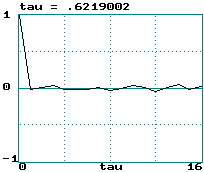
-
Logit transform of logistic equation:
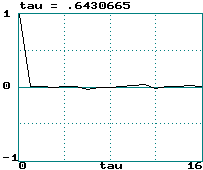
-
Hénon map:
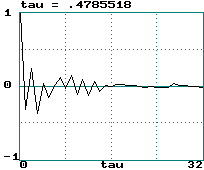
-
Sine wave:
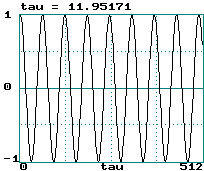
-
Lorenz attractor (x variable step size 0.05):
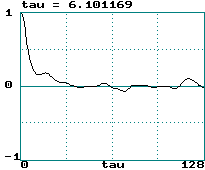
-
A broad power spectrum gives a narrow correlation function
and vice versa
[cf: the Uncertainty Principle (tDf
~ 1)]
-
Colored (correlated) noise is indistinguishable
from chaos
-
Correlation time is width of g(t)
function (call it tau)
-
It's hard to define a unique value of this width
-
This curve is really symmetric about tau = 0 (hence width is 2 tau)
-
0.5/tau is sometimes called a "poor-man's Lyapunov exponent"
-
Noise: LE = infinity ==> tau = 0
-
Logistic map: LE = loge(2) ==> tau
= 0.72
-
Hénon map: LE = 0.419 ==> tau = 1.19
-
Sine wave: LE = 0 ==> tau = infinity
-
Lorenz attractor: LE = 0.906/sec = 0.060/step ==>
tau = 8.38
-
This really only works for tau > 1
-
Testing this would make a good student project
-
The correlation time is a measure of how much "memory" the
system has
-
g(1) is the linear correlation coefficient (or "Pearson's
r")
It measures correlation with the preceding point
-
If g(1) = 0 then there is no correlation
White (f 0) noise: 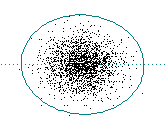
-
If g(1) ~ 1 then there is strong correlation
Pink (1/f) noise: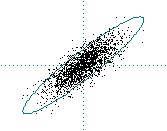
-
If g(1) < 0 then there is anti-correlation
Blue (f 2) noise: 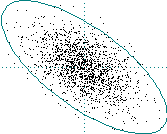
(This was produced by taking the time derivative of white noise)
-
From the correlation function g(n), the power spectrumP(f)
can be found:
P(f) = 2 S g(n)
cos(2pfnDt)
Dt
(ref: Tsonis)
 Time-Delayed Embeddings
Time-Delayed Embeddings
-
How do you know what variable to measure in an experiment?
-
How many variables do you have to measure?
-
The wonderful answer is that (usually) it doesn't matter!
-
Example (Lorenz attractor - HW #10):
-
Plot of y versus x:
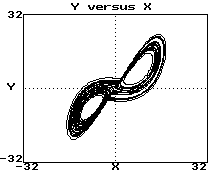
-
Plot of dx/dt versus x:
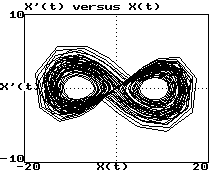
-
Plot of x(t) versus x(t-0.1):
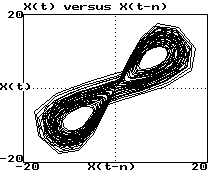
-
These look like 3 views of the same object
-
They are "diffeomorphisms"
-
They have same topological properties (dimension, etc.)
-
Whitney's embedding theorem says this result is general
-
Taken's has shown that DE = 2m
+ 1
-
m is the smallest dimension that contains the attractor
(3 for Lorenz)
-
DE is the minimum time-delay embedding
dimension (7 for Lorenz)
-
This guarantees a smooth embedding (no intersections)
-
This is the price we pay for choosing an arbitrary variable
-
Removal of all intersections may be unnecessary
-
Recent work has shown that 2m may be sufficient (6 for Lorenz)
-
In practice m often seems to suffice
-
Example (Hénon viewed in various ways):
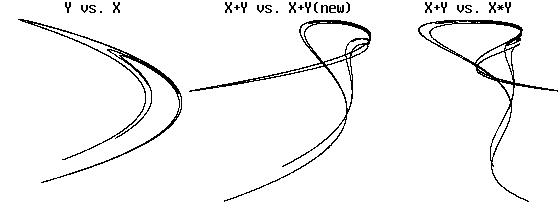
There is obvious folding, but topology is preserved
-
How do we choose an appropriate DE (embedding
dimension)?
-
Increase DE until topology of attractor (dimension) stops
changing
-
This may require more data than you have to do properly
-
Saturation of attractor dimension is usually not excellent
-
Example: 3-torus (attractor
dimension versus DE , 1000 points)
-
Can also use the method of false nearest neighbors:
-
Find the nearest neighbor to each point in embedding DE
-
Increase DE by 1 and see how many former nearest neighbors
are no longer nearest
-
When the fraction of these false neighbors falls to nearly zero, we have
found the correct embedding
-
Example: 3-torus
-
How do we choose an appropriate Dt
for sampling a flow?
-
In principle, it should not matter
-
In practice there is an optimum
-
Rule of thumb: Dt ~ tau / DE
-
Vary Dt until tau is about DE
(3 to 7 for Lorenz)
-
A better method is to use minimum
mutual information (see Abarbanel)
 Summary of Important
Dimensions
Summary of Important
Dimensions
-
Configuration space (number of independent dynamical variables)
-
Solution manifold (the space in which the solution "lives" - an
integer)
-
Attractor dimension (fractional if it's a strange attractor)
-
Kaplan-Yorke (Lyapunov) dimension
-
Hausdorff dimension
-
Capacity dimension (see below)
-
Information dimension
-
Correlation dimension (next week)
-
... (infinitely many more)
-
Observable (1-D for a univariate time series: Xi)
-
Reconstructed (time-delayed) state space (can be chosen arbitrarily)
-
Time-delayed embedding (the minimum time-delayed state space that
preserves the topology of the solution)
 Nonlinear Prediction
Nonlinear Prediction
-
There are many forecasting (prediction) methods:
-
Extrapolation (fitting data to a function)
-
Moving average (MA) methods
-
Linear autoregression (ARMA)
-
State-space averaging (see below)
-
Principal component analysis (PCA)
(also called singular value decomposition - SVD)
-
Machine learning / AI (neural nets, genetic algorithms, etc.)
-
Conventional linear prediction methods apply in the time domain
-
Fit the data to a mathematical function (polynomial, sine,
etc.)
-
The function is usually not linear, but assume that the equations
governing the dynamics are (hence no chaos)
-
Evaluate the function at some future time
-
This works well for smooth and quasi-periodic data
-
It (usually) fails badly for chaotic data
-
Nonlinear methods usually apply in state space
-
Lorenz proposed this method for predicting the weather
-
Example (predicting next term in Hénon map - HW #
11):
-
We know Xn+1 = 1 - CXn2
+ BXn-1
-
In a 2-D embedding, the next value is unique
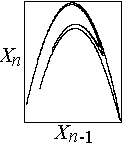
-
Find M nearest points in Xn-Xn-1
space
-
Calculate their average displacement: DX
= <Xn+1 - Xn>
-
Use DX to predict next value in
time series
-
Repeat as necessary to get future time steps
-
Sensitive dependence will eventually spoil the method
-
Growth of prediction error crudely gives the Lyapunov exponent
-
Example (Hénon map average error):

-
If LE = 0.604 bits/iterations, error should double every 1.7 iterations
-
Saturation occurs after error grows sufficiently
-
The method also can remove some noise
-
Predict all points not just next point
-
Need to choose DE and M optimally
-
Alternate related method is to construct f(Xn,
Xn-1,
...)
-
This improves noise reduction but is less accurate
-
Best method is to make a local function approximation
-
Usually linear or quadratic functions are used
-
This offers best of both worlds but is hard to implement
and slow
 Lyapunov Exponent of
Experimental Data
Lyapunov Exponent of
Experimental Data
-
We previously calculated largest LE from known equations
-
Getting the LE from experimental data is much more difficult (canned
routines are recommended - See Wolf)
-
Finding a value for LE may not be very useful
-
Noise and chaos both have positive LEs (LE = infinity
for white noise)
-
Quasiperiodic dynamics have zero LE, but there are better
ways to detect it (look for discrete power spectrum)
-
The value obtained is usually not very accurate
-
Conceptually, it's easy to see what to do:
-
Find two nearby points in an embedding DE
-
Follow them a while and calculate <log(rate of separation)>
-
Repeat with other nearby points until you get a good average
-
There are many practical difficulties:
-
How close do the points have to be?
-
What if they are spuriously close because of noise?
-
What if they are not oriented in the right direction?
-
How far can they safely separate?
-
What do you do when they get too far apart?
-
How many pairs must be followed?
-
How do you choose the proper embedding?
-
It's especially hard to get exponents other than the largest
-
The sum of the positive exponents is called the entropy
 Capacity Dimension
Capacity Dimension
-
The most direct indication of chaos is a strange attractor
-
Strange attractors will generally have a low, non-integer dimension
-
There are many ways to define and calculate the dimension
-
We already encountered the Kaplan-Yorke dimension, but it requires
knowledge of all the Lyapunov exponents
-
A more direct method is to calculate the capacity dimension (D0)
-
Capacity dimension is closely related to the Hausdorff dimension
-
It is also sometimes called the "cover dimension"
-
Consider data representing a line and a surface embedded
in 2-D
-
The number of squares N of size d required to cover the line
(1-D) is proportional to 1/d
-
The number of squares N of size d required to cover the surface
(2-D) is proportional to 1/d2
-
The number of squares N of size d required to cover a fractal
(dimension D0) is proportional to 1/dD0
-
Hence the fractal dimension is given by D0
= d log(N) / d log(1/d)
-
This is equivalent to D0 = -d log(N)
/ d log(d)
-
Plot log(N) versus log(d) and take the slope
to get D0
-
Example (2000 data points from Hénon
map with DE = 2)
-
This derivative should be taken in the limit d --> 0
-
The idea can be generalized to DE > 2 using (hyper)cubes
-
Many data points are required to get a good result
-
The number required increases exponentially with D0
J. C. Sprott | Physics 505
Home Page | Previous Lecture | Next
Lecture














